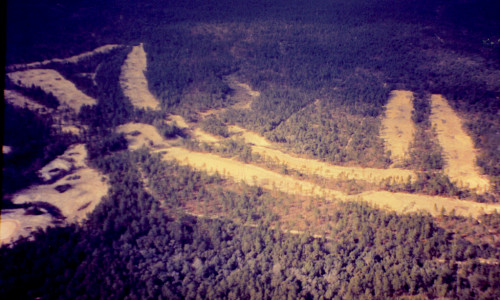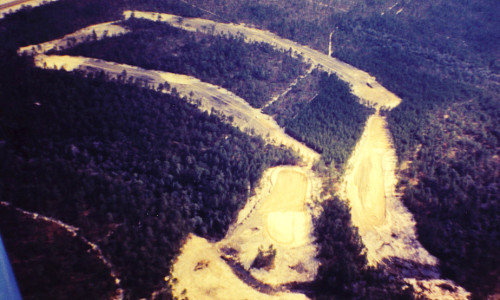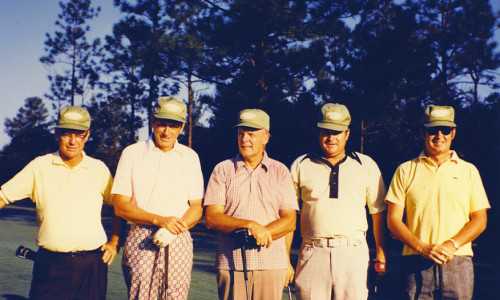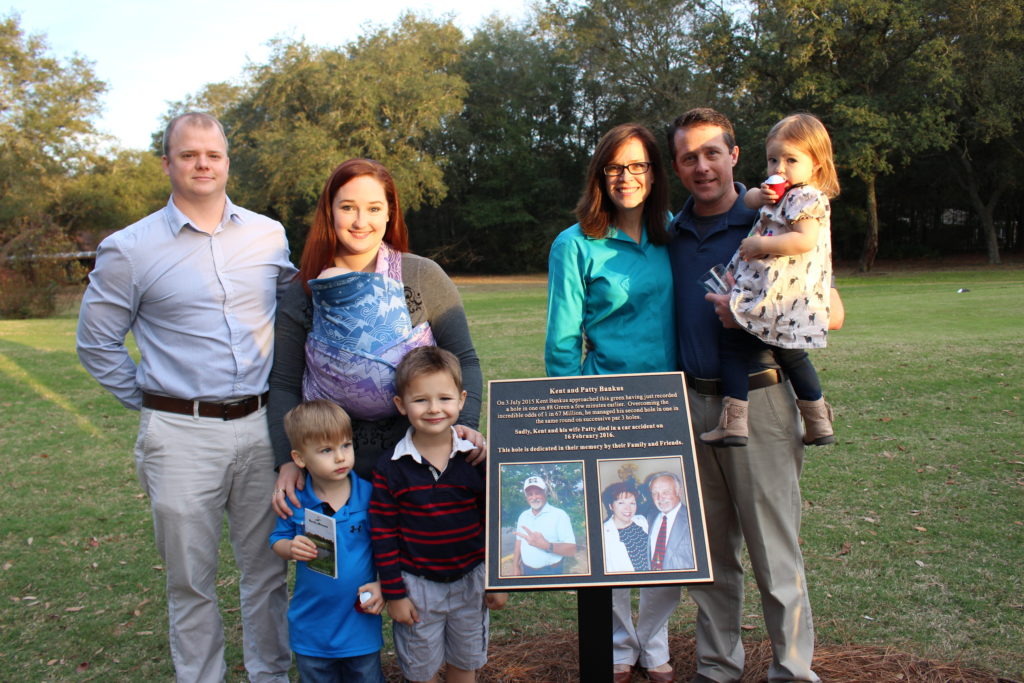RBCC – A Very Special Place
IN THE BEGINNING
By Robert McKelvey
THE INITIAL PLANNING
A private country club with a nice clubhouse, a challenging 18-hole course, swimming pool, and tennis courts for the Twin Cities of Niceville and Valparaiso. In the late 1960s and early 1970s this might have sounded like the impossible dream. But it was precisely such a concept that prompted a group of Twin Cities residents to begin meeting in the early part of 1971 to explore what would be required to build such a facility.
For some two years prior, there had been random, informal discussions between several community leaders about what could be done to unite the cities of Niceville and Valparaiso. Jack Nichols, then-member of the Okaloosa County Commission representing the Twin Cities Area, engaged in a series of individual discussions with citizens of both cities concerning the need for a recreational and social vehicle that residents of both cities could use and enjoy together. Such possibilities as a yacht club were examined. The idea of a country club with golf, swimming and tennis, and a clubhouse capable of supporting area-wide social gatherings caught on quickly as the best possibility.
When Commissioner Nichols spoke to Frank Edge, (who was the Twin Cities most prominent amateur golfer) about the idea, Edge responded enthusiastically. Edge and Nichols met at Edge’s home and compiled a list with more than 115 names of local golfers and citizens who they felt would support such a project. In subsequent individual discussions with some of the people they had listed, the response was overwhelmingly favorable. Out of these discussions came the informal planning group that began to meet regularly.
One of the first steps of the group was to approach C. Walter Ruckel, President of Ruckel Properties, who was the primary landowner and developer in the Twin Cities area, to ascertain his interest in working with this group in planning such a facility, Ruckel’s response was immediate and positive. Within two weeks after a first contact by Joe Sadler, representing the planning group, Ruckel pledged his support. It was this action by Ruckel that really opened the doors and made the concept of a Country Club a real possibility and not just an impossible dream.
By early 1972, the informal planning group had organized itself into an official executive committee and applied to the State of Florida for a Certificate of Incorporation. The state issued a certificate dated April 7, 1972 with the following officers and directors:
- FRANK EDGE, PRESIDENT, Niceville, Florida
- PLENN PHELPS, VICE PRESIDENT, Niceville, Florida
- JACK NICHOLS, SECRETARY, Niceville, Florida
- WILLIAM H. POWELL, TREASURER, Niceville, Florida
- JOE SADLER, DIRECTOR, Valparaiso, Florida
- FERROL SPENCE, DIRECTOR, Niceville, Florida
- C. WALTER RUCKEL, DIRECTOR, Valparaiso, Florida
- A. J. KINNEY, DIRECTOR, Niceville, Florida
- ROBERT McKELVEY, DIRECTOR, Valparaiso, Florida
- ED SLOWN, DIRECTOR, Valparaiso, Florida
- GREGORY M. ANCHORS, DIRECTOR, Niceville, Florida
- J.C. GARDNER, DIRECTOR, Valparaiso, Florida
Within this group there was consensus that golfers in the Twin Cities area faced a dismal future concerning a place to play. The Golf Course at Eglin was the only course in the immediate area. Memberships there were limited; securing tee times was difficult; for those fortunate enough to be associate members they had no voice in the operation of the course and their memberships were subject to termination if military requirements warranted such action. Newcomers to the area unless they were active or retired military or civil service employees had no place to play, so a private club owned and operated by its members was much more than a dream. It was already an immediate need, and looking further into the future it was a necessity.
No one within this original group had any previous experience in planning and building a country club. But they all shared a love for golf and a conviction that collectively they could develop a plan and direct its implementation. There were frequent meetings and numerous individuals who became a part of the project. Each member of the executive committee played important roles devoting many hours of their time in chairing the various committees. Frank Edge, the first President, was a major force in moving the project through the planning and construction phases. Without the support and cooperation of Walt Ruckel, the course could never have been built; Jack Nichols was already at work on a County Commission plan to extend College Boulevard to Rocky Bayou Road. He agreed to provide an access road off of this extension into the area where the golf course was to be built. This was an important step in the overall plan.
LEASE AGREEMENT WITH RUCKEL PROPERTIES
The official lease agreement is dated December 8, 1971. It provided for a 99-year lease with an option to renew on approximately 215 acres, located in Section 3 and 4, Township 1 South, Range 22 West, Okaloosa County, Florida. The site was located in a beautifully wooded area northwest of Rocky Bayou. Two pretty spring-fed streams crossed the area. Portions of these streams were dammed to provide four lakes around which the club house, golf course, swimming pool, and tennis courts were built. Ruckel Properties would plan and develop a residential complex around the golf course and lakes.
The lease stipulated that the Club would build and operate the facility. It stated that the Club and Ruckel Properties would share equally the cost of constructing any dams and lakes as agreed to between them. It specified that if the Club failed to have at least 300 fully paid members and to construct and operate the course within three years of the date of this agreement it would be void.
In consideration for the lease the Club agreed to pay Ruckel Properties an annual sum equal to 2% of all gross income received by the Club from the activities conducted on the leased premises provided that the gross income is in excess of $90,000 per annum and less than $20,000 per annum. When the gross annual income exceeds $120,000 the sum paid to Ruckel Properties shall be a sum equal to 4%. Gross income was defined as including all income derived from membership dues, green fees, cart rentals, and driving range income, but shall exclude all income received from the bar, snack bar, and pro-shop.
This lease agreement was the real catalyst that moved the project from a fantasy to a reality. With no beginning assets, the acquisition of sufficient property to build a Country Club through outright purchase would have been financially impossible. The market value of the 215 acres at the time would surely have exceeded five million dollars. The amount of the lease payments required from the Club were quite generous and within the Club’s financial capability, Happily, the construction of the country club substantially escalated the value of the properties to be developed by Ruckel Properties. So it became a mutually beneficial arrangement for both parties.
DESIGN AND CONSTRUCTION
It was agreed at the outset that the facility would include an 18-hole golf course, a club house, swimming pool, and tennis courts. The services of William W. Amick, Golf Course Architect, Daytona Beach, Florida, was finalized in an agreement dated August 21, 1972. The terms and provisions of the agreement included the following:
Preliminary and final layout of the course to include 18 holes, practice facility, putting green.
Construction drawings to include the layout and drawings for an automated irrigation system.
Written specifications.
For these services the Club agreed to pay Amick the total sum of $19,600. The agreement required the architect to make four visits to the site during the construction phase at no additional cost. If the Club requested additional visits, the architect would be paid $200 plus expenses for each visit.
One feature of the golf course design requiring 50 feet of rough area on each side of the each fairway resulted in a layout that does not have residential homes infringing on the Golf Course, This is a distinctive feature of Rocky Bayou and contributes to its beauty and play-ability.
The original drawings for the greens were reduced in size from their initial design by 25%. The Golf Committee concluded that a reduction was warranted thereby enhancing play and reducing maintenance costs. In so doing, some of the traps around the greens were not repositioned and are farther from the putting surface than normal. Otherwise, the course today is essentially the same as the original plans that were first presented to the Club by Mr. Amick.
The Robert B. Werk Construction Company was selected to build the course for a total cost of $293,258. The services to be provided included clearing and shaping the areas for tees, fairways, and greens and traps; grassing the tees, fairways, and greens and installation of then system. Construction work was completed in September 1973. The work proceeded smoothly without any major problems or delays.
Phelps Construction Company of Niceville, Florida was the contractor for the clubhouse. Its design provided two levels including a large ball room area, food and drink service facilities, ladies’ and men’s locker rooms, board conference room, and a cart storage area. It was intended to be available to the members for private parties, weddings, bridge, luncheons and other social activities. The total cost of the facility was $104,000. The swimming pool and tennis courts were constructed for a combined cost of approximately $30,000. The road paving and parking areas added an additional $10,000 to the cost of the Facility.
MEMBERSHIPS
Four categories of memberships were offered at $350 each, with the goal of maximum total membership of 400 members. The categories were as follows:
“A” Membership – Family of two or more members for use of all facilities.
“B” Membership – One person only for use of all facilities.
“C” Membership. Family of two or more persons for use of all club facilities except the Golf Course.
“D” Membership – Inactive at the time of purchase but the privilege of converting to “A”, “B”, or “C” membership at any future time.
The initial monthly dues for “A” members were set at $20. For “B” members at $15, for “C” members at $10. No monthly dues were required for “D” members.
An attractive brochure describing the plans for the Club was prepared and used extensively in the campaign to recruit members. A kick-off rally at the Rocky Bayou Fish Camp was a huge success with more than 100 signees. By August 1972 the Club had 292 paid members and by May 1973, the maximum number of 400 had been reached. On August 28, 1972 a motion to raise memberships to 400 was approved to be effective September 1, 1972.
Provision was made to classify all categories of members as Shareholding Charter Members provided the purchase was made prior to August 1, 1972. It was stipulated that any Shareholding Charter Member would have the right at any time to become an active dues-paying member except that this option could not be exercised more than one time. Shareholding members alone had an interest in the property of the Club and the right to vote. A total of 292 members were classified initially as Shareholding Charter Members.
BY LAWS
The original By-Laws were officially adopted September 30, 1973 and provided for a Board of Directors of 13 members. The term of each Director was to be for three years and no Director would serve more than two consecutive terms. The Board would organize itself by electing a President, Vice President, Secretary and Treasurer, all of which would serve one year terms. The Board of Directors was authorized to control and manage all affairs, property, and expenditures of the Club including the appointment of all committees deemed necessary for conducting the affairs of the Club. Any expenditures for improvement or expansion of existing facilities which exceeded $20,000 required the approval by a majority of the shareholders at a duly called meeting.
The following standing committees were established:
- FINANCE AND BUDGET
- GOLF COURSE AND GROUNDS
- GOLF
- ADMISSIONS
- SWIMMING
- TENNIS
- NOMINATING
Provision was made for an Annual Meeting of the Shareholders on the first Tuesday in April of each year. A quorum of at least 40 Shareholders was established. Special meetings were provided by action of the Board of Directors or by written request of any 40 Shareholders.
Procedures for the selling or transfer of Shareholder Memberships were set forth. No individual could hold more than one share. Honorary Memberships could be conferred by a majority vote of the Shareholders upon recommendation of the Board of Directors. The requirements for resignation, leaves of absence, and forfeiture of Memberships were set forth. The Board of Directors was authorized to regulate the extension of privileges of the Club and its facilities to guests.
The fiscal year was defined as beginning on April 1 and ending on March 31. A two thirds affirmative vote of the Shareholders was required for any amendments, rescissions, alterations or additions to the By-Laws. The Board of Directors was responsible for deciding all questions of interpretation of the By-Laws.
AT THE CONCLUSION
September 29, 1973 was a big day; any day when a dream comes true is a big day. A first class country club for the Niceville-Valparaiso area officially opened for play. Frank Edge was recognized for his tireless efforts in guiding and supervising the building of the course by hitting the first ball off the first tee. The first foursome followed Frank and played the entire 18 holes.
Members of that foursome included C, Walter Ruckel, Plenn Phelps, A. J. Kinney, and Robert McKelvey.
There was still much work to be done. The swimming pool and tennis courts were not finished; the rough areas needed to be cleared; final touches to the club house were needed, but so many people had done so much with so little that one could only stand amazed at the reality of it all. It was great and would only get better. For years to come Rocky Bayou Country Club would provide a lot of people a place to enjoy the great game of golf. For those who preferred to play tennis or go swimming, they too could enjoy themselves. And finally a club house was now available for social activities for groups large and small. A dream had come true. Plaudits and kudos to a relatively small group of Twin Cities residents for a work well done was the order of the day.
Remembering Kent and Patty Bankus
Marking the one year anniversary of the deaths of Kent and Patty Bankus in an automobile accident in Alabama, family and friends gathered at Rocky Bayou Country Club to dedicate two holes in their honor. Kent, a long-time member of Rocky Bayou, had the distinct accomplishment of making consecutive holes-in-one on Holes #8 and #12 in the same round on July 3, 2015. The odds of this happening are 1 in 67 million. Kent’s son, Kyle, and wife, Dawna, and Kent and Patty’s daughter, Katie Murray and husband Wes, plus their four children, Bennett, Leander, Mavie and Kent were in attendance. A champagne toast at sunset and unveiling of a unique plaque completed the event.






